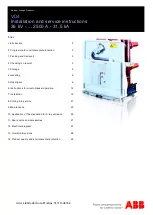
SECTIO N 1 5-EC Trip Device (Cont.)
1 5.2.3 INSTANTANEOUS TRIPPING
(a) Adjustable instantaneous tripping takes place after the
magnetic force produced by an overcurrent condition, over
comes the restraining force of the calibration spring which can
be adjusted by the calibration clamp nut (1 4).
(b) Non-adjustable instantaneous tripping takes place after
the magnetic force produced by an overcurrent condition over
comes the restraining force of a non-adjustable spring.
1 5.2.4 EC-1 ADJUSTMENTS
Before attempting any checks or adjustments on breaker with
EC trip devices, the breaker mechanism and trip latch should be
checked to assure their proper functioning so that the breaker
trip shaft is free of high friction loads. The trip latch of the
breaker should also be checked for proper trip latch engage
ment. See Section 7. 1 5
EC-1 Devices may have their pick-up settings varied by
changing the positions of the sliding calibration plates on the
front of each device. The clamping nut holding the plate must
be loosened to make the change, and then retightened.
If a new device is installed, the adjusting screw on the tripping
arm must be set to give 1 /32nd of an inch overtravel in tripping.
The method for making this check is demonstrated in Figure
1 24.
The rod shown is used for pushing the armature of device
closed. If this is done with the device mounted on a closed
breaker, it will simulate the action which occurs when the device
reacts to an overload condition.
FIG. 1 24 CHECKING TRAVEL DISTANCE OF
SERIES OVERCURRENT TRIPPING
DEVICE.
88
1 5.3
POSITIVE TRIP ADJUSTMENT
Before attempting any checks or adjustments on breaker with
EC trip devices, the breaker mechanism and trip latch should be
checked to assure their proper functioning so that the breaker
trip shaft is free of high friction loads. The trip latch of the
breaker should also be checked for proper trip latch engage
ment. See Section 7 . 1 5
I n addition to the pick-up settings and time-delay adjustments
already described, overcurrent trip devices must be adjusted for
positive tripping. This adjustment is made at the factory on new
breakers, but must be made in the field when the breaker mech
anism or the overcurrent trip devices have been replaced.
Positive tripping is achieved when adjustment screw (9) Fig
ure
1 24
is in such a position that it will always carry the trip pad
dle on the trip shaft beyond the point of tripping the mechanism,
when the armature closes against the magnet.
In order to make the adjustment, first unscrew trip screws (9),
Figure
1 24,
until it will not trip the breaker even though the ar
mature is pushed against the magnet. Then, holding the arma
ture in the closed position, advance the screw until it just trips
the breaker. After this point has been reached, advance the
screw two additional full turns. This will give an overtravel of 1 1
1 6 of an inch and will make sure that activation of the device will
always trip the breaker.
Adjustment screw (9), Figure
1 23
can best be manipulated by
an extended 1 /4 inch hex socket wrench.
www
. ElectricalPartManuals
. com





































